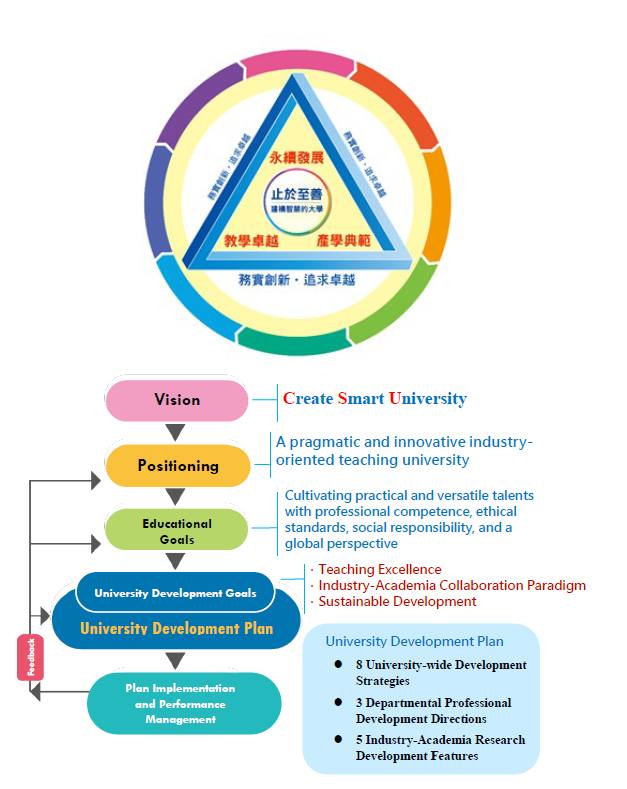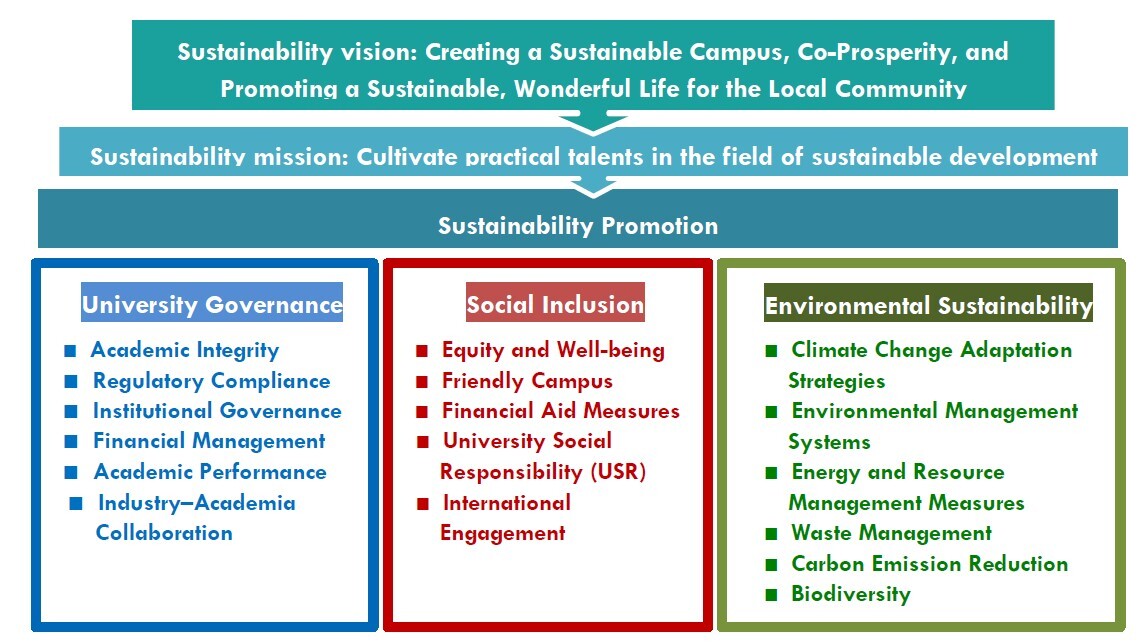Sustainable Vision
The Importance and Significance of Sustainability
Since its founding, Cheng Shiu University has upheld the motto “Strive for Perfection” in both educational philosophy and institutional practice, dedicating itself to cultivating skilled professionals who meet industry needs. Through value chain analysis, the University conducts an in-depth review of its sustainability initiatives, ensuring that every decision fully considers its impact on students, faculty, staff, the community, and industry partners. This strategic approach amplifies positive influence, driving meaningful change toward achieving sustainability goals.
 |
University Development Vision
CSU’s sustainable governance focuses on three innovation pillars: learning, teaching, and institutional mechanisms. Building on a strong foundation in education, research, and industry collaboration, the University blends innovation with practicality, linking industry and campus to showcase its distinctive pragmatic-innovation approach. This supports its mission to cultivate professionals with expertise, ethics, social responsibility, and a global perspective, advancing the institutional goals of teaching excellence, industry-academia leadership, and sustainable development.
University Development Plan
To realize the University’s vision, CSU has formulated its Institutional Development Plan based on a SWOT analysis, taking into account major domestic and international trends, industry and societal needs, national development plans, and education policies. The plan is structured into three key areas: overall institutional development strategies, departmental professional development directions, and industry–academia research development features, all aimed at advancing sustainable university operations. The framework is illustrated as follows:
School's Overall Development Strategies

Sustainable Development Strategy

Alignment with SDGs
School Development Strategies and Corresponding SDGs
|
Overall development strategies |
SDGs |
Responsible Unit |
University Development Goals |
|
Strategy one: |
     |
Office of Academic Affairs, Division of Continuing Education |
Teaching Excellence |
|
Strategy two: |
            |
Office of Student Affairs |
Sustainable Development |
|
Strategy three: |
          |
Office of Research and Development |
Industry-Academia Collaboration Paradigm |
|
Strategy four: |
    |
Office of International Affairs Office of Research and Development (Center for Continuing Education) |
Teaching Excellence |
|
Strategy five: |
      |
Center for General Education, Teacher Education Center, Office of Academic Affairs (Foreign Language Center, Physical Education Center), Office of Student Affairs (Military Training and Campus Security Center) |
Teaching Excellence |
|
Strategy six: |
    |
Office of Library and Information Services, Office of Technology and Arts Development |
Industry-Academia Collaboration Paradigm |
|
Strategy seven: |
          |
Office of Human Resources, Office of Accounting, Office of General Affairs |
Sustainable Development |
|
Strategy Eight: |
   |
Office of the Secretariat, Office of Audit, Office of Admissions, Office of Academic Affairs (Project Planning Division, Comprehensive Planning Division, Teaching Development Center) |
Sustainable Development |
Sustainability Advancement Practices
|
Aspect |
Current Status |
Short Term (1–2 years) |
Medium Term (3–5 years) |
|
University Governance |
Compile sustainability reports in line with international standards |
Sustainability report preparation process incorporates internal control mechanisms and continuously updates medium- and long-term sustainability goals. |
|
|
Publish the University Social Responsibility (USR) annual report |
Implementation of SROI (Social Return on Investment) |
Prepare a mid- to long-term USR evaluation report to track outcomes. |
|
|
Establish an ESG data collection mechanism |
Optimize ESG data management to build a data-driven sustainability performance evaluation system. |
||
|
Environmental |
Adopt the TCFD framework |
Regularly identify climate-related risks and opportunities, conduct scenario analyses, and develop response measures. |
|
|
Conduct greenhouse gas inventories |
Replace outdated equipment to improve energy efficiency. |
Plan and install solar photovoltaic systems. |
|
|
Implement green procurement plans |
Continuously monitor and analyze carbon emissions data to adjust next year’s energy-saving and carbon-reduction measures. |
||
|
Social |
Strengthen curriculum alignment with the SDGs |
Further integrate SDGs into curricula to enhance sustainability literacy among faculty and students. |
|
|
Execute USR projects |
Strengthen community sustainability awareness and collaboration through USR projects. |
||
|
Organize ESG talent development courses |
Expand impact and international linkages, including industry carbon neutrality and smart technology initiatives. |
||

